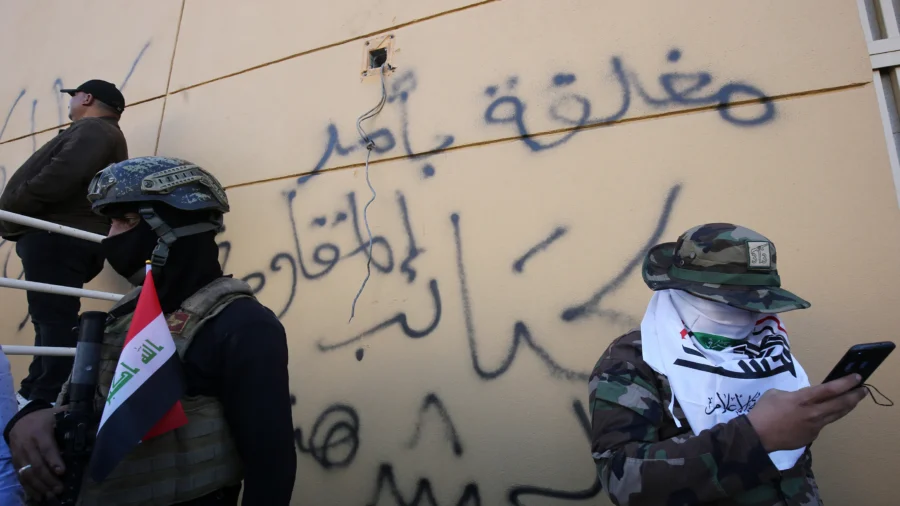Iran-backed fighters in western Iraq attacked international coalition forces at Iraq’s Ain Al-Asad (also al-Assad which means “the Lion”) Airbase on Saturday night, causing injuries to Iraqi and U.S. personnel.
U.S. Central Command (CENTCOM) said that at approximately 6:30 p.m., multiple ballistic missiles and rockets were launched targeting the major airbase. Although many of the missiles were intercepted by the base’s air defense systems, others hit their target.
“Damage assessments are ongoing,” CENTCOM said in a statement. “A number of U.S. personnel are undergoing evaluation for traumatic brain injuries. At least one Iraqi service member was wounded.”
The airbase, which is considered the westerly equivalent of Baghdad’s Green Zone, previously came under attack by a ballistic missile on Nov. 20, marking a major escalation with the use of the more destructive ballistic missiles, which left eight personnel wounded. The United States responded with a retaliatory strike, killing several Iranian-backed militia members.
The base also suffered from a major attack on Jan. 8, 2020, by an estimated 30 Iranian ballistic missiles.
At the time, Iran’s Islamic Revolutionary Guard Corps (IRGC) claimed responsibility, saying the action was in response to the U.S. drone strike that killed Qassem (also Qasem or Qasim) Soleimani—the leader of the IRGC’s Quds Force, the Iranian regime’s foreign military arm—a few days earlier. The targeted hit was in response to Soleimani “actively developing plans to attack American diplomats and service members in Iraq and throughout the region,” U.S President Donald Trump and the Pentagon said at the time.
After that, the Pentagon installed Patriot air defense systems at the base for its defense.
According to initial reports on Saturday, the attack consisted of around 15 rockets, of which 13 were successfully intercepted. However, two hit the base.
An Iran-linked group that calls itself the “Islamic Resistance in Iraq” released a statement on Saturday claiming responsibility for the attack.
IRGC Spy Chief for Syria Killed
Earlier on Saturday, Tehran said that an Israeli strike on a multi-story residential building had killed the IRGC’s spy chief for Syria Brigadier General Sadegh Omidzadehh (also Hojjatollah Omidvar or “Hajj Sadegh”), his deputy, and three other IRGC members in the Mazzeh neighborhood of Damascus, which is also where the local U.N. headquarters and foreign embassies are located. State media affiliated with the IRGC also named Ali Aghazadeh, Hossein Mohammadi, and Saeed Karimi as advisers killed in the attack.
According to reports, the Syrian defense ministry reported additional civilian casualties at the residential complex, whom the director of the UK-based Syrian Observatory for Human Rights described to the AFP as “Iran-aligned leaders.” The leaders were allegedly gathered for a meeting at the IRGC-owned building in a neighborhood known by locals as a high-security zone for IRGC leaders and pro-Iran Palestinian factions.
Tehran threatened reprisals, with state media reporting that Iran’s foreign ministry returned blame to Israel for a “desperate attempt to spread instability in the region” as both regional powers continue to fight for influence.
U.S. and Coalition forces in the region have been facing renewed attacks from Iranian proxies in the region since mid-October following the Hamas terrorist group’s attack on Israel on Oct. 7, 2023. The Pentagon said that dozens of U.S. personnel have been lightly wounded in the ongoing attacks, which have exceeded 100 in Iraq and Syria since Oct. 7.
On several occasions, the Pentagon has launched strikes that it said were to prevent imminent attacks or for deterrence measures. Iranian proxies are involved in a strategic game of expelling U.S. forces from the region, Pentagon Press Secretary Air Force Maj. Gen. Pat Ryder said on Dec. 12 last year.
Israel Continues Offensive to Neutralize Hamas
In recent months, Israel has intensified its strikes on senior Iranian and allied figures in Syria and Lebanon, where Iran-backed Hezbollah is operating, as its military operation to wipe out Hamas’s military capabilities continues.
In December, Israel killed senior Iranian general Razi Moussavi, the leader of the IRGC’s Quds Force in Syria, in an airstrike. Moussavi was a close companion of Soleimani.
On Jan. 2, Israel was blamed for a strike in Lebanon that killed Hamas deputy Saleh al-Arouri. This was followed by a lethal strike on top Hezbollah commander Wissam Tawil in his car in south Lebanon.
On Jan. 16, the Pentagon said that it had seized a boatload of “advanced conventional weapons” over the weekend that Iran was sending to the Houthis who have been attacking international vessels in the Red Sea from Yemen, to call for an end to Israel’s military campaign against Hamas in Gaza.
Currently, there are roughly 2,500 American troops in Iraq and some 900 in Syria.
The U.S. officially withdrew its presence from the base as part of Operation Iraqi Freedom in 2011, only to return in 2014 as part of the international coalition alongside Iraqi forces against the ISIS terrorist group after it seized large parts of the country before being defeated.
From The Epoch Times


